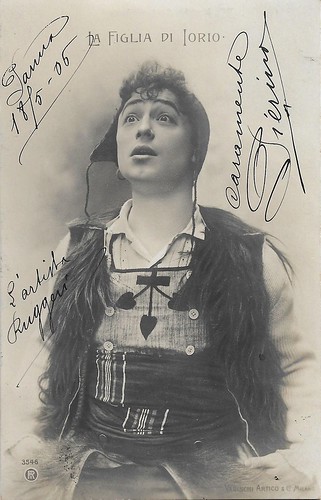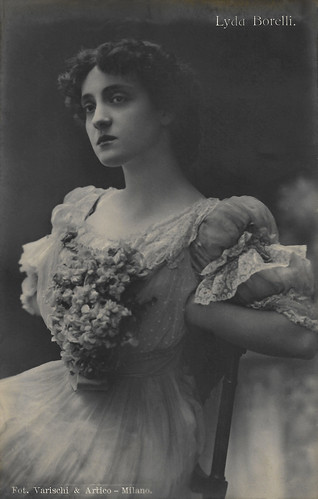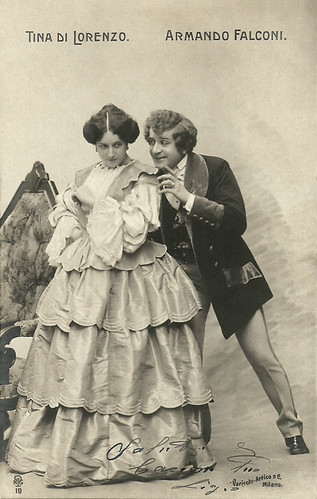In 1900, Italian photographers Arturo Varischi and Giovanni Artico assumed ownership of the L. Ricci portrait studio where they had both trained as employees. Varischi & Artico gained a reputation for infant portraits and for their ability to attract famous actors like Lyda Borelli, Irma Gramatica and Tina di Lorenzo, but also musicians, singers, and writers to their studio. For this post, we selected 25 film and stage star postcards with portraits by Varischi & Artico.
![Lyda Borelli]()
Italian postcard. Photo: Varischi & Artico. Lyda Borelli.
Lyda Borelli (1887-1959) was already an acclaimed stage actress before she became the first diva of Italian silent cinema. The fascinating film star caused a craze among female fans called 'Borellismo'.
![Lyda Borelli]()
Italian postcard by RA, no. 2015. Photo: Varischi Artico & Co., Milano. Lyda Borelli.
![Lyda Borelli]()
Italian postcard by RA, no. 2023. Photo: Varischi Artico & Co, Milano. Lyda Borelli.
![Lyda Borelli]()
Italian postcard by RA, no. 2125. Photo: Varischi Artico & Co., Milano. Lyda Borelli.
![Lyda Borelli and Giannina Chiantoni in La figlia di Jorio]()
Italian postcard by RA, no. 2120. Photo: Varischi Artico & Co, Milano. Lyda Borelliand Giannina Chiantoni in Gabriele D'Annunzio's stage play 'La figlia di Jorio' (1904)
![Lyda Borelli in La figlia di Jorio]()
Italian postcard by RA, no. 2152. Photo: Varischi Artico Co., Milano. Lyda Borelli as Favetta in the stage play 'La figlia di Jorio' by Gabriele D'Annunzio (1904).
In 1903, Gabriele D'Annunzio wrote the drama 'La figlia di Jorio' (The Daughter of Jorio), a pastoral tragedy situated in the Abruzzi mountains in the centre of Italy. On 2 March 1904, the stage company Talli-Calabresi-Grammatica performed the premiere of the play at the Teatro Lirico in Milan. The protagonist should have been Eleonora Duse, but she fell ill. D' Annunzio, whose relationship with Duse was fading, didn't wait for her healing and gave the female lead to Irma Grammatica - which hurt Duse dearly. The painter Francesco Paolo Michetti, a good friend of D'Annunzio, designed the sets and costumes. The play was a huge success, also in Chieti in Abruzzi when it was performed there the same year. In 1907, with D'Annunzio's permission, a version in the Abruzzi dialect was written and performed.
![Giannina Chiantoni as Ornella in La figlia di Jorio (1904)]()
Italian postcard by RA, no. 3515. Photo: Varischi Artico & Co., Milano. Giannina Chiantoni as Ornella in 'La figlia di Jorio' (1904).
![Ruggero Ruggeri in La figlia di Jorio (1906)]()
Italian postcard by RA, no. 3546. Photo: Varischi Artico.& Co., Milano. Mailed 18 May 1906. Ruggero Ruggeri as Aligi in 'La figlia di Jorio' (1904).
![Oreste Calabresi in La figlia di Jorio]()
Italian postcard by RA, no. 3557. Photo: Varischi Artico & Co., Milano. Oreste Calabresi as Lazaro in 'La figlia di Jorio' ( 1904).
![Lyda Borelli]()
Italian postcard. Photo: Varischi & Artico, Milano. Lyda Borelli.
![Lyda Borelli]()
Italian postcard. Photo: Varischi & Artico, Milano. Lyda Borelli.
![Lyda Borelli]()
Italian postcard. Photo: Varischi & Artico, Milano. Lyda Borelli.
In 1900, Arturo Varischi and Giovanni Artico became the owners of the portrait studio and photo laboratory of Leone Ricci in Milano, Italy, where they had both been trained.
Ricci had started his daguerreotype business already before 1850 and thus was one of the earliest photographers in Milano. His studio had a long history of portraying the Milanese bourgeoisie and aristocracy and Varischi & Artico Company continued this tradition.
Giovanni Artico was born in Vittorio Veneto in 1868. After his studies in chemistry, he established himself in Milan. Like many young contemporaries, he was interested in the upcoming business of photography. He chose to start working in the portrait studio of Leone Ricci.
There he met another employee, Arturo Varischi, and the two decided to take over Ricci's business.
The two photographers conveniently shared their business location (first Corso Vittorio Emanuele 110-111, later Corso Vittorio Emanuele 22) with Angelo Pettazzi, an established merchant and producer of photographic equipment and supplies.
Most of the photos of Varischi & Artico date from 1900-1920, while the company name was first spelt as Varischi, Artico & Co., and later on as Varischi & Artico Co. On postcards, the credit reads Fot. Varischi & Artico - Milano - as on the postcard above.
![Irma Gramatica]()
Italian postcard by TCR, no. 1. Photo: Varischi Artico & Co., Milano. Irma Gramatica.
Irma Gramatica (1867-1962) was an Italian stage and screen actress, known for her talent but also for her temper.
![Irma Gramatica]()
Italian postcard by TCR, no. 2. Photo: Varischi Artico & Co., Milano. Irma Gramatica.
![Mercedes Brignone]()
Italian postcard by RA, no. 2027. Photo: Varischi Artico e C., Milano. Mercedes Brignone.
Mercedes Brignone (1885-1967) was an Italian theatre, film and television actress. She was a major star in Italian silent cinema of the 1910s and early 1920s. In the 1930s and early 1940s, she often played secondary parts in Italian sound films.
![Mercedes Brignone]()
Italian postcard by RA, no. 2052. Photo: Varischi Artico & Co. Milano. Mercedes Brignone.
![Mercedes Brignone]()
Italian postcard by AR, no. 2055. Photo: Varischi Artico e C., Milano. Mercedes Brignone.
![Mercedes Brignone]()
Italian postcard by RA, no. 2061. Photo: Varischi Artico & Co. Milano. Sent by mail in Belgium in 1917. Mercedes Brignone.
![Mercedes Brignone]()
Italian postcard by RA, no. 2074. Photo: Varischi Artico & Co. Milano. Sent by mail in Belgium in 1906. Mercedes Brignone.
![Mercedes Brignone]()
Italian postcard by NPG, no. 1. Photo: Varischi Artico e C., Milano. Mercedes Brignone.
Arturo Varischi and Giovanni Artico soon gained a reputation for their infant portraits. They were also known for their ability in attracting famous artists to their studio. Renowned opera performers from the Scala flocked to Varischi & Artico Co. for their publicity by use of souvenir photographs and picture postcards.
They also attracted famous musicians like Arturo Toscanini, stage actors and writers to their studio. Soon also the first film stars were portrayed by them. One of their most popular subjects was the first diva of the silent Italian cinema, Lyda Borelli. Notable is also their series of colour portraits.
Arturo Varischi died prematurely. In 1923 Artico took over on his own and transformed the 19th-century portrait studio into a modern business.
Giovanni Artico died in 1930, and his widow, Regina Trelancia, continued the activities till 1933. Later their son Carlo Artico also became a photographer and reopened Studio Artico in Milan.
In the archive of Studio Artico, there are about 70 original photos of famous personalities like author Giovanni Verga and actress Tina de Lorenzo, which were signed by the sitters. They show the artistry and craftsmanship of Artico. Many prints of his work can be found in archives all over Italy, especially in Milan.
![Tina Di Lorenzo]()
Italian postcard by NPG, no. 2. Photo: Varischi Artico & C., Milano. Tina Di Lorenzo.
Tina Di Lorenzo (1872-1930) was one of the 'grand dames' of the Italian stage during the early twentieth century, nicknamed "Angelicata" and "La encantadora". In 1915 she also acted in two or three films. In 1901 she married reputed stage actor Armando Falconi, who would have a second career in Italian sound cinema.
![Tina Di Lorenzo]()
Italian postcard by NPG, no. 13. Photo: Varischi Artico & C., Milano. Sent by mail on 12 May 1903. Tina Di Lorenzo.
![Armando Falconi and Tina Di Lorenzo]()
Italian postcard by NPG, no. 19. Photo: Varischi Artico & C., Milano. Armando Falconi and Tina Di Lorenzo.
Armando Falconi (1871-1954) was an Italian stage and screen actor. Though he was foremost a theatre actor and comedian, he had a prolific career as a comedian in Italian cinema of the 1930s and early 1940s. He was married to the famous stage actress Tina Di Lorenzo, with whom he also often acted together.
![Tina Di Lorenzo]()
Italian postcard by NPG, no. 23. Photo: Varischi Artico & C., Milano. Sent by mail on 18-12-1903. Tina Di Lorenzo.
![Tina Di Lorenzo]()
Italian postcard by NPG, no. 39. Photo: Varischi Artico & C., Milano. Tina Di Lorenzo.
![Lidia Gauthier]()
Italian postcard by NPG, no. 3. Photo: Varischi Artico & C., Milano.
Lidia Gauthier (?-?) is a little-known Italian stage actress who in the 1900s though knew a certain reputation and was portrayed by photo studios such as Varischi Artico. She acted e.g. at the stage company of Teresa Mariani, where Gianna Chiantoni was the leading actress.
![Elisa Severi]()
Italian postcard by NPG, no. 4. Photo: Varischi Artico & C., Milano.
Elisa Severi (1872-1930) started as a stage actress. She joined the Drammatica Compagnia Palladini-Talli in 1894, and headed a company with Oreste Calabresi for the 1905-1906 season, with Mercedes Brignone as one of the company's other actresses. Severi appeared in twenty silent films between 1913 and 1921. She was the grandmother of the famous film director Mario Monicelli.
![Giulia Cassini Rizzotto]()
Italian postcard by NPG, no. 10. Photo: Varischi Artico & C., Milano.
Giulia Cassini Rizzotto (1865-1943) was an Italian actress and film director, kindergarten teacher, novelist, translator and writer. She appeared in many films in Italy including Malombra (1917) and Fabiola (1918) and directed five films herself. She was married to the actor Alfonso Cassini.
Sources: Giovanna Ginex (Varischi e Artico fotografi a Milano: i primi decenni del secolo), Silvia Paoli (Lo studio e laboratorio fotografico Artico, Rivista di storia e fotografia, no. 24, II, december 1996), Max Hochstetler (Luminous Lint), and Claudia Morgan (Commune di Trieste) (Italian).

Italian postcard. Photo: Varischi & Artico. Lyda Borelli.
Lyda Borelli (1887-1959) was already an acclaimed stage actress before she became the first diva of Italian silent cinema. The fascinating film star caused a craze among female fans called 'Borellismo'.

Italian postcard by RA, no. 2015. Photo: Varischi Artico & Co., Milano. Lyda Borelli.

Italian postcard by RA, no. 2023. Photo: Varischi Artico & Co, Milano. Lyda Borelli.

Italian postcard by RA, no. 2125. Photo: Varischi Artico & Co., Milano. Lyda Borelli.

Italian postcard by RA, no. 2120. Photo: Varischi Artico & Co, Milano. Lyda Borelliand Giannina Chiantoni in Gabriele D'Annunzio's stage play 'La figlia di Jorio' (1904)

Italian postcard by RA, no. 2152. Photo: Varischi Artico Co., Milano. Lyda Borelli as Favetta in the stage play 'La figlia di Jorio' by Gabriele D'Annunzio (1904).
In 1903, Gabriele D'Annunzio wrote the drama 'La figlia di Jorio' (The Daughter of Jorio), a pastoral tragedy situated in the Abruzzi mountains in the centre of Italy. On 2 March 1904, the stage company Talli-Calabresi-Grammatica performed the premiere of the play at the Teatro Lirico in Milan. The protagonist should have been Eleonora Duse, but she fell ill. D' Annunzio, whose relationship with Duse was fading, didn't wait for her healing and gave the female lead to Irma Grammatica - which hurt Duse dearly. The painter Francesco Paolo Michetti, a good friend of D'Annunzio, designed the sets and costumes. The play was a huge success, also in Chieti in Abruzzi when it was performed there the same year. In 1907, with D'Annunzio's permission, a version in the Abruzzi dialect was written and performed.

Italian postcard by RA, no. 3515. Photo: Varischi Artico & Co., Milano. Giannina Chiantoni as Ornella in 'La figlia di Jorio' (1904).

Italian postcard by RA, no. 3546. Photo: Varischi Artico.& Co., Milano. Mailed 18 May 1906. Ruggero Ruggeri as Aligi in 'La figlia di Jorio' (1904).

Italian postcard by RA, no. 3557. Photo: Varischi Artico & Co., Milano. Oreste Calabresi as Lazaro in 'La figlia di Jorio' ( 1904).

Italian postcard. Photo: Varischi & Artico, Milano. Lyda Borelli.

Italian postcard. Photo: Varischi & Artico, Milano. Lyda Borelli.

Italian postcard. Photo: Varischi & Artico, Milano. Lyda Borelli.
Daguerreotype business
In 1900, Arturo Varischi and Giovanni Artico became the owners of the portrait studio and photo laboratory of Leone Ricci in Milano, Italy, where they had both been trained.
Ricci had started his daguerreotype business already before 1850 and thus was one of the earliest photographers in Milano. His studio had a long history of portraying the Milanese bourgeoisie and aristocracy and Varischi & Artico Company continued this tradition.
Giovanni Artico was born in Vittorio Veneto in 1868. After his studies in chemistry, he established himself in Milan. Like many young contemporaries, he was interested in the upcoming business of photography. He chose to start working in the portrait studio of Leone Ricci.
There he met another employee, Arturo Varischi, and the two decided to take over Ricci's business.
The two photographers conveniently shared their business location (first Corso Vittorio Emanuele 110-111, later Corso Vittorio Emanuele 22) with Angelo Pettazzi, an established merchant and producer of photographic equipment and supplies.
Most of the photos of Varischi & Artico date from 1900-1920, while the company name was first spelt as Varischi, Artico & Co., and later on as Varischi & Artico Co. On postcards, the credit reads Fot. Varischi & Artico - Milano - as on the postcard above.

Italian postcard by TCR, no. 1. Photo: Varischi Artico & Co., Milano. Irma Gramatica.
Irma Gramatica (1867-1962) was an Italian stage and screen actress, known for her talent but also for her temper.

Italian postcard by TCR, no. 2. Photo: Varischi Artico & Co., Milano. Irma Gramatica.

Italian postcard by RA, no. 2027. Photo: Varischi Artico e C., Milano. Mercedes Brignone.
Mercedes Brignone (1885-1967) was an Italian theatre, film and television actress. She was a major star in Italian silent cinema of the 1910s and early 1920s. In the 1930s and early 1940s, she often played secondary parts in Italian sound films.

Italian postcard by RA, no. 2052. Photo: Varischi Artico & Co. Milano. Mercedes Brignone.

Italian postcard by AR, no. 2055. Photo: Varischi Artico e C., Milano. Mercedes Brignone.

Italian postcard by RA, no. 2061. Photo: Varischi Artico & Co. Milano. Sent by mail in Belgium in 1917. Mercedes Brignone.

Italian postcard by RA, no. 2074. Photo: Varischi Artico & Co. Milano. Sent by mail in Belgium in 1906. Mercedes Brignone.

Italian postcard by NPG, no. 1. Photo: Varischi Artico e C., Milano. Mercedes Brignone.
Performers of the Scala
Arturo Varischi and Giovanni Artico soon gained a reputation for their infant portraits. They were also known for their ability in attracting famous artists to their studio. Renowned opera performers from the Scala flocked to Varischi & Artico Co. for their publicity by use of souvenir photographs and picture postcards.
They also attracted famous musicians like Arturo Toscanini, stage actors and writers to their studio. Soon also the first film stars were portrayed by them. One of their most popular subjects was the first diva of the silent Italian cinema, Lyda Borelli. Notable is also their series of colour portraits.
Arturo Varischi died prematurely. In 1923 Artico took over on his own and transformed the 19th-century portrait studio into a modern business.
Giovanni Artico died in 1930, and his widow, Regina Trelancia, continued the activities till 1933. Later their son Carlo Artico also became a photographer and reopened Studio Artico in Milan.
In the archive of Studio Artico, there are about 70 original photos of famous personalities like author Giovanni Verga and actress Tina de Lorenzo, which were signed by the sitters. They show the artistry and craftsmanship of Artico. Many prints of his work can be found in archives all over Italy, especially in Milan.

Italian postcard by NPG, no. 2. Photo: Varischi Artico & C., Milano. Tina Di Lorenzo.
Tina Di Lorenzo (1872-1930) was one of the 'grand dames' of the Italian stage during the early twentieth century, nicknamed "Angelicata" and "La encantadora". In 1915 she also acted in two or three films. In 1901 she married reputed stage actor Armando Falconi, who would have a second career in Italian sound cinema.

Italian postcard by NPG, no. 13. Photo: Varischi Artico & C., Milano. Sent by mail on 12 May 1903. Tina Di Lorenzo.

Italian postcard by NPG, no. 19. Photo: Varischi Artico & C., Milano. Armando Falconi and Tina Di Lorenzo.
Armando Falconi (1871-1954) was an Italian stage and screen actor. Though he was foremost a theatre actor and comedian, he had a prolific career as a comedian in Italian cinema of the 1930s and early 1940s. He was married to the famous stage actress Tina Di Lorenzo, with whom he also often acted together.

Italian postcard by NPG, no. 23. Photo: Varischi Artico & C., Milano. Sent by mail on 18-12-1903. Tina Di Lorenzo.

Italian postcard by NPG, no. 39. Photo: Varischi Artico & C., Milano. Tina Di Lorenzo.

Italian postcard by NPG, no. 3. Photo: Varischi Artico & C., Milano.
Lidia Gauthier (?-?) is a little-known Italian stage actress who in the 1900s though knew a certain reputation and was portrayed by photo studios such as Varischi Artico. She acted e.g. at the stage company of Teresa Mariani, where Gianna Chiantoni was the leading actress.

Italian postcard by NPG, no. 4. Photo: Varischi Artico & C., Milano.
Elisa Severi (1872-1930) started as a stage actress. She joined the Drammatica Compagnia Palladini-Talli in 1894, and headed a company with Oreste Calabresi for the 1905-1906 season, with Mercedes Brignone as one of the company's other actresses. Severi appeared in twenty silent films between 1913 and 1921. She was the grandmother of the famous film director Mario Monicelli.

Italian postcard by NPG, no. 10. Photo: Varischi Artico & C., Milano.
Giulia Cassini Rizzotto (1865-1943) was an Italian actress and film director, kindergarten teacher, novelist, translator and writer. She appeared in many films in Italy including Malombra (1917) and Fabiola (1918) and directed five films herself. She was married to the actor Alfonso Cassini.
Sources: Giovanna Ginex (Varischi e Artico fotografi a Milano: i primi decenni del secolo), Silvia Paoli (Lo studio e laboratorio fotografico Artico, Rivista di storia e fotografia, no. 24, II, december 1996), Max Hochstetler (Luminous Lint), and Claudia Morgan (Commune di Trieste) (Italian).